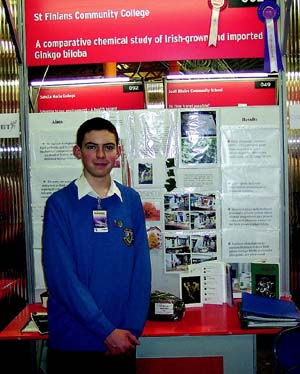| 2004 |

|
YEAR BOOK |
St Finian's Community College, Swords, Co. Dublin
|
A comparative chemical study of Irish-grown and imported
Ginkgo biloba
|

Medicinally, it has a vast number of uses. It can help to alleviate asthma, improve circulation, heal vision and hearing impairments, improve memory function and, remarkably, it is proven to slow the progression of Alzheimer's disease and other forms of senile dementia. These are just a few uses of dozens. It can be taken in tablet form, tincture (alcoholic extract), and its leaves can be made into a tea.
In my project, 'A comparative chemical study of Irish grown and imported Ginkgo biloba ', I attempted to observe the similarities and possible differences between three samples of Ginkgo biloba leaves: dried Irish grown leaves (thanks to Paul Maher and Seamus O'Brien, National Botanical Gardens, Glasnevin), frozen Irish grown leaves, and dried imported leaves. Using a Sohxlet apparatus (kindly loaned by DCU), each sample was extracted using three different solvents. The solvents used were increasingly polar, and the extractions were carried out in the order of hexane, ethyl acetate (ethyl ethanoate), and finally methanol.
These extracts were then examined and compared using Thin-Layer Chromatography (TLC). They were compared to five standard leaf constituents: chlorogenic acid, rutin hydrate, ginkgolide A, ginkgolide B, and bilobalide (these standards were kindly donated by DCU). After addition of acetone (propanone) to the Irish grown dried leaves methanol extract, a cloudy precipitate was achieved, that occurred exclusively in this sample. The precipitate was filtered using a Hirsch funnel, but it decayed rapidly on exposure to air. During the course of the TLCs, a number of compounds remained unidentified. Hopefully, further investigation will be able to identify these.
I am very grateful to Dr Ingrid Hook of the Department of Pharmocognosy, Trinity College Dublin, for her assistance and interest, and to Gabrielle MacAuley and Catherine Lang of Bioforce for their help and support, and Ms O'Brien, without whom this project could not have happened.
David O'Shea won First Prize in the Junior Individual Category in the Chemical, Physical and Mathematical Sciences Section at the EsatBT Young Scientist & Technology Exhibition in January 2004. He also won a Special Award presented by Shaw Scientific Limited. His teacher was Ms Eleanor O Brien.
| This article was sponsored by Shaw Scientific Limited |
|---|